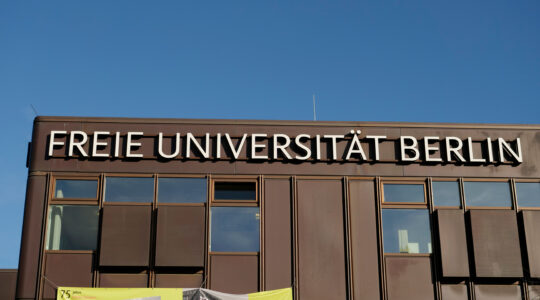ARAVA DESERT, Israel (JTA) – King Solomon of biblical fame would be paying close attention to the Mexican flag flying over the yellow sliding gate in front of the rocky desert hills just south of the Timna Park Reserve in southern Israel.
About 18 miles north of Eilat along the stretch of Route 90, the stark, rocky Timna Valley hills are about to host what could be the most important mining activity in the region since the Egyptians turned the reserve into a large-scale copper industry during the reign of the Pharaohs 3,400 years ago.
But while industrialists and others are excited about the economic benefits the mine could bring to the area, others are concerned that those benefits could be short-lived and overstated. There are serious concerns as well about how the mine could affect the local environment and what damage it may do to the scenery surrounding it – a desert landscape that brings in thousands of tourists per year.
The Timna Valley reserve is home to a tourist site called King Solomon’s Mines run by Kibbutz Elifaz just north of the mining complex. It is believed that copper was first mined on this site nearly 8,000 years ago. Thousands of tourists visit every year to walk in the stark desert scenery complete with pillars, remains of temples and former smelting camps on site.
The Egyptians had major operations here, but the link to King Solomon in the 10th century BCE is tenuous.
More than two years ago, the Israeli government granted exclusive rights to a local subsidiary of Ahmsa, the industrial giant traded on the Mexican stock market, to run a pilot program in the area. With some 35 workers and engineers, the Israeli subsidiary Arava Mines Ltd. has been analyzing rock samples from an underground area of 3,000 acres in the mining complex.The last mining operation here, publicly owned and run by the Israeli government, was shut down after more than 25 years in 1985, when copper prices plunged.
Ahmsa says that about 20,000 tons of copper could be dug out of the ground annually for the next 10 years. Regional officials and a ministerial planning committee are waiting for a final environmental impact statement from Ahmsa, to be delivered in January, before deciding whether to authorize digging. The planning committee has the final word.
An Arava Mines-Ahmsa official in Herzliya refused to comment for this article, preferring to wait until a press conference scheduled for Tuesday.
Dorit Benit has not yet been invited to the press conference. The head of the environmental unit of the Eilat and Arava Regional Councils, she is among the officials waiting for the impact statement.
Benit says many people in Eilat and the kibbutzim along Route 90 believe the project, which will be one of the largest mining operations in Israel, is good and should bring people and money to the region. Some are mostly worried about the environment.
“There are still unresolved issues on air quality and the amount of dust in the air, finding alternative sites to crush the rock and leech the metal from it with sulfuric acid, finding adequate electricity and water supplies and repairing damaged land,” Benit said. “There are about 40 questions that must be answered before we can approve any digging.”
Others, she said, question how much copper the mine will actually yield.
“The Ahmsa people are taking this very seriously and have done the pilot test program by the book,” she said. “I just wonder how much copper there really is there. When they began over two years ago, everyone was talking about 40,000 tons annually for 10 years. Now it is 20,000 tons.”
David Lehrer, director of the Arava Institute, an environmental research institute on Kibbutz Ketura, about 12 miles north of Timna, stressed the environmental risks.
“Ahmsa is talking about hundreds of jobs and apartments in Eilat, and that is all good, but there is a conflict here,” Lehrer said. “Copper mining is very far from an environmentally friendly industry. The sulfuric acid used to leech the copper metal from the dirt is toxic. There is a risk of groundwater pollution, soil loss and air pollution.”
Lehrer noted that the dirt would be put back as the ore is extracted.
“We all know this is not pit mining, but we want a proper closing,” he said. “We don’t want the site to look like a heavy-industry wasteland. Thousands of visitors walk for hours in the Timna Reserve hills just north.”
Benit and Lehrer voiced concerns over the economics involved in pushing ahead with the mining. The Ahmsa company is heralding the creation of some 400 new jobs for workers and engineers.
“Let’s be honest, there are not several hundred engineers sitting around Eilat and the kibbutzim waiting to be hired,” Benit said, “so people will come from elsewhere to fill the jobs. But the original figure was 700 jobs, and now I hear it is 400.”
Lehrer said that “when copper prices crash, if the mine suddenly closes, we want there to be a provision in the budget to re-landscape the hills after closing.”
Asa Fishel, a 20-year resident of Kibbutz Grofit, about nine miles north of the mines, said he trusts the regional council people on the environmental side.
“I know Dorit, and she will do what’s best for the region,” Fishel said.
But, he added, once the environmental issues have been addressed, another problem will remian.
“Housing is critical in the Arava Valley and even in Eilat,” said Fishel, the acting general secretary of his kibbutz. “The bottom line is that the kibbutzim have built next to nothing beyond limited housing for members for years. People come to me as secretary with housing requests, so I can tell you for sure that there are no available apartments here or on the other kibbutzim in the area during holidays and all summer.”
Fishel added that apartments are available in Eilat, but not 400 of them – not even 100.
“There are hotels, lots of them in Eilat, but at certain times they are full of French tourists and other Europeans,” he said.
“It’s funny, I know we have missed the boat on building housing down here for both visitors and residents, and this situation drives the point home. We simply have not made the necessary investment down here, and once mining engineers are knocking on the doors looking for housing, it may be too late.”
JTA has documented Jewish history in real-time for over a century. Keep our journalism strong by joining us in supporting independent, award-winning reporting.





